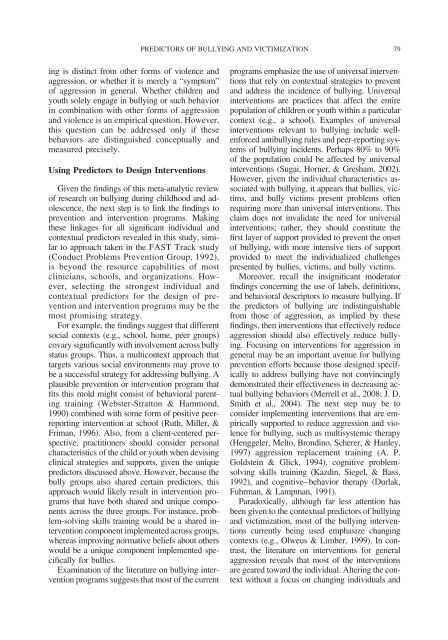Predictors of Bullying and Victimization in Childhood and Adolescence
Predictors of Bullying and Victimization in Childhood and Adolescence
Predictors of Bullying and Victimization in Childhood and Adolescence
Create successful ePaper yourself
Turn your PDF publications into a flip-book with our unique Google optimized e-Paper software.
<strong>in</strong>g is dist<strong>in</strong>ct from other forms <strong>of</strong> violence <strong>and</strong><br />
aggression, or whether it is merely a “symptom”<br />
<strong>of</strong> aggression <strong>in</strong> general. Whether children <strong>and</strong><br />
youth solely engage <strong>in</strong> bully<strong>in</strong>g or such behavior<br />
<strong>in</strong> comb<strong>in</strong>ation with other forms <strong>of</strong> aggression<br />
<strong>and</strong> violence is an empirical question. However,<br />
this question can be addressed only if these<br />
behaviors are dist<strong>in</strong>guished conceptually <strong>and</strong><br />
measured precisely.<br />
Us<strong>in</strong>g <strong>Predictors</strong> to Design Interventions<br />
Given the f<strong>in</strong>d<strong>in</strong>gs <strong>of</strong> this meta-analytic review<br />
<strong>of</strong> research on bully<strong>in</strong>g dur<strong>in</strong>g childhood <strong>and</strong> adolescence,<br />
the next step is to l<strong>in</strong>k the f<strong>in</strong>d<strong>in</strong>gs to<br />
prevention <strong>and</strong> <strong>in</strong>tervention programs. Mak<strong>in</strong>g<br />
these l<strong>in</strong>kages for all significant <strong>in</strong>dividual <strong>and</strong><br />
contextual predictors revealed <strong>in</strong> this study, similar<br />
to approach taken <strong>in</strong> the FAST Track study<br />
(Conduct Problems Prevention Group, 1992),<br />
is beyond the resource capabilities <strong>of</strong> most<br />
cl<strong>in</strong>icians, schools, <strong>and</strong> organizations. However,<br />
select<strong>in</strong>g the strongest <strong>in</strong>dividual <strong>and</strong><br />
contextual predictors for the design <strong>of</strong> prevention<br />
<strong>and</strong> <strong>in</strong>tervention programs may be the<br />
most promis<strong>in</strong>g strategy.<br />
For example, the f<strong>in</strong>d<strong>in</strong>gs suggest that different<br />
social contexts (e.g., school, home, peer groups)<br />
covary significantly with <strong>in</strong>volvement across bully<br />
status groups. Thus, a multicontext approach that<br />
targets various social environments may prove to<br />
be a successful strategy for address<strong>in</strong>g bully<strong>in</strong>g. A<br />
plausible prevention or <strong>in</strong>tervention program that<br />
fits this mold might consist <strong>of</strong> behavioral parent<strong>in</strong>g<br />
tra<strong>in</strong><strong>in</strong>g (Webster-Stratton & Hammond,<br />
1990) comb<strong>in</strong>ed with some form <strong>of</strong> positive peerreport<strong>in</strong>g<br />
<strong>in</strong>tervention at school (Ruth, Miller, &<br />
Friman, 1996). Also, from a client-centered perspective,<br />
practitioners should consider personal<br />
characteristics <strong>of</strong> the child or youth when devis<strong>in</strong>g<br />
cl<strong>in</strong>ical strategies <strong>and</strong> supports, given the unique<br />
predictors discussed above. However, because the<br />
bully groups also shared certa<strong>in</strong> predictors, this<br />
approach would likely result <strong>in</strong> <strong>in</strong>tervention programs<br />
that have both shared <strong>and</strong> unique components<br />
across the three groups. For <strong>in</strong>stance, problem-solv<strong>in</strong>g<br />
skills tra<strong>in</strong><strong>in</strong>g would be a shared <strong>in</strong>tervention<br />
component implemented across groups,<br />
whereas improv<strong>in</strong>g normative beliefs about others<br />
would be a unique component implemented specifically<br />
for bullies.<br />
Exam<strong>in</strong>ation <strong>of</strong> the literature on bully<strong>in</strong>g <strong>in</strong>tervention<br />
programs suggests that most <strong>of</strong> the current<br />
PREDICTORS OF BULLYING AND VICTIMIZATION<br />
programs emphasize the use <strong>of</strong> universal <strong>in</strong>terventions<br />
that rely on contextual strategies to prevent<br />
<strong>and</strong> address the <strong>in</strong>cidence <strong>of</strong> bully<strong>in</strong>g. Universal<br />
<strong>in</strong>terventions are practices that affect the entire<br />
population <strong>of</strong> children or youth with<strong>in</strong> a particular<br />
context (e.g., a school). Examples <strong>of</strong> universal<br />
<strong>in</strong>terventions relevant to bully<strong>in</strong>g <strong>in</strong>clude wellenforced<br />
antibully<strong>in</strong>g rules <strong>and</strong> peer-report<strong>in</strong>g systems<br />
<strong>of</strong> bully<strong>in</strong>g <strong>in</strong>cidents. Perhaps 80% to 90%<br />
<strong>of</strong> the population could be affected by universal<br />
<strong>in</strong>terventions (Sugai, Horner, & Gresham, 2002).<br />
However, given the <strong>in</strong>dividual characteristics associated<br />
with bully<strong>in</strong>g, it appears that bullies, victims,<br />
<strong>and</strong> bully victims present problems <strong>of</strong>ten<br />
requir<strong>in</strong>g more than universal <strong>in</strong>terventions. This<br />
claim does not <strong>in</strong>validate the need for universal<br />
<strong>in</strong>terventions; rather, they should constitute the<br />
first layer <strong>of</strong> support provided to prevent the onset<br />
<strong>of</strong> bully<strong>in</strong>g, with more <strong>in</strong>tensive tiers <strong>of</strong> support<br />
provided to meet the <strong>in</strong>dividualized challenges<br />
presented by bullies, victims, <strong>and</strong> bully victims.<br />
Moreover, recall the <strong>in</strong>significant moderator<br />
f<strong>in</strong>d<strong>in</strong>gs concern<strong>in</strong>g the use <strong>of</strong> labels, def<strong>in</strong>itions,<br />
<strong>and</strong> behavioral descriptors to measure bully<strong>in</strong>g. If<br />
the predictors <strong>of</strong> bully<strong>in</strong>g are <strong>in</strong>dist<strong>in</strong>guishable<br />
from those <strong>of</strong> aggression, as implied by these<br />
f<strong>in</strong>d<strong>in</strong>gs, then <strong>in</strong>terventions that effectively reduce<br />
aggression should also effectively reduce bully<strong>in</strong>g.<br />
Focus<strong>in</strong>g on <strong>in</strong>terventions for aggression <strong>in</strong><br />
general may be an important avenue for bully<strong>in</strong>g<br />
prevention efforts because those designed specifically<br />
to address bully<strong>in</strong>g have not conv<strong>in</strong>c<strong>in</strong>gly<br />
demonstrated their effectiveness <strong>in</strong> decreas<strong>in</strong>g actual<br />
bully<strong>in</strong>g behaviors (Merrell et al., 2008; J. D.<br />
Smith et al., 2004). The next step may be to<br />
consider implement<strong>in</strong>g <strong>in</strong>terventions that are empirically<br />
supported to reduce aggression <strong>and</strong> violence<br />
for bully<strong>in</strong>g, such as multisystemic therapy<br />
(Henggeler, Melto, Brond<strong>in</strong>o, Scherer, & Hanley,<br />
1997) aggression replacement tra<strong>in</strong><strong>in</strong>g (A. P.<br />
Goldste<strong>in</strong> & Glick, 1994), cognitive problemsolv<strong>in</strong>g<br />
skills tra<strong>in</strong><strong>in</strong>g (Kazd<strong>in</strong>, Siegel, & Bass,<br />
1992), <strong>and</strong> cognitive–behavior therapy (Durlak,<br />
Fuhrman, & Lampman, 1991).<br />
Paradoxically, although far less attention has<br />
been given to the contextual predictors <strong>of</strong> bully<strong>in</strong>g<br />
<strong>and</strong> victimization, most <strong>of</strong> the bully<strong>in</strong>g <strong>in</strong>terventions<br />
currently be<strong>in</strong>g used emphasize chang<strong>in</strong>g<br />
contexts (e.g., Olweus & Limber, 1999). In contrast,<br />
the literature on <strong>in</strong>terventions for general<br />
aggression reveals that most <strong>of</strong> the <strong>in</strong>terventions<br />
are geared toward the <strong>in</strong>dividual. Alter<strong>in</strong>g the context<br />
without a focus on chang<strong>in</strong>g <strong>in</strong>dividuals <strong>and</strong><br />
79
















